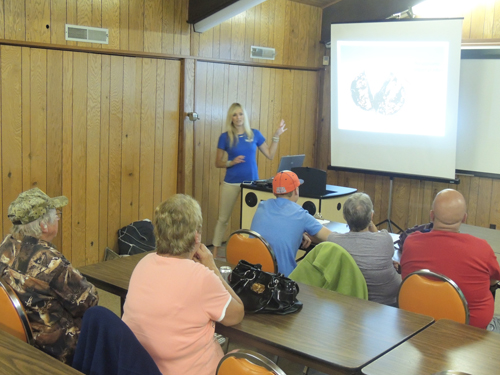Invasive Species Could Creep into Armstrong Waters

Sea Grant Biologist Sara Stahlman, from Erie, explains different invasive species to a small group at the Crooked Creek Environmental Learning Center in Manor Township last week.
by Jonathan Weaver
Boaters traveling along the Allegheny River or traveling to places like Pymatuming State Park in Crawford County this Summer should heed warning: there could be invasive species traveling with you.
Biologist Sara Stahlman, from Sea Grant– a national network of universities that performs scientific research and educates students and the public on marine issues – spoke to boaters and fishers at the Crooked Creek Environmental Learning Center in Manor Township last week about hydrilla, carp and the “poster child” of invasive species: zebra mussels.
“These are considered one of the greatest threats to fresh water biodiversity worldwide – second only to habitat loss and climate change,” Stahlman said.
“These species don’t care about jurisdictional boundaries that we put up.”
For example, the flathead catfish that can be caught locally is considered “highly invasive” in the eastern portion of the state.
Zebra mussels are introduced to streams to make the water clear, but make a thick shell around anything living or nonliving.
Another invasive species are Asian carp – famous for jumping up to 10 feet out of the water when frightened by an electric motor.
Stahlman said the invasive species – which primarily come via ballast water from the Caspian Sea – can cause ecological harm or to other species as well as hard to local tourism areas and potential health impacts to both humans and dogs.
She said fishers should also think a second longer before disposing of unused bait.
“A lot of people will go out fishing, they have their baits in a bucket and when they’re done (and) they didn’t use all their bait, they dump it out (into the water) and that’s a huge issue,” Stahlman said. “Never ever dump your bait – always put it in the trash – unless you yourself caught the bait and know it’s from the same water where you were fishing.”
Environmental Learning Center Program Director Dennis Hawley explained he was introduced to the Sea Grant program by longtime Roaring Run Watershed volunteer John Linkes. Hawley contacted Stahlman in November.
“I went to their website and saw that they were available to do programs, and thought (a program o invasive species) was something that would be really interesting down here,” Hawley said. “I think it’s very important – people don’t think about those things when they’re moving bait and their equipment from one stream to another, don’t realize the implications they can have.”
Stahlman – also a fellow fisher and boater who lives in Erie – speaks to tournament fishers before competitions and check their boats for invasive species, as well as school groups regularly.
“I travel all over to give programs. People ask me all the time, and if I’m available, I’ll do them,” Stahlman said. “(They are) usually invasive species programs.
“A lot of what we do is take scientific information that’s very technical and complicated at times and bring it down to a level that we can convey that information to the public about things that are going on.”
Her research also took her to Argentina and other places in the United States
After graduating from Penn State Behrend with a degree in biology, Stahlman started at the Tom Ridge Environmental Center along Presque Isle doing research on brown bullhead catfish in Presque Isle 10 years ago. She has since also worked in Harrisburg and earned a Master’s degree from Shippensburg University before returning to her hometown.
Vince Bruno, of Kittanning, attended the presentation with wife, Patty, and grandson, Dawson Porter – who fishes in the Allegheny River and other local creeks.
“It was interesting – very interesting,” Bruno said.
Stahlman also cautioned against releasing goldfish and turtles into natural waters as they can also be considered invasive in a different environment.


